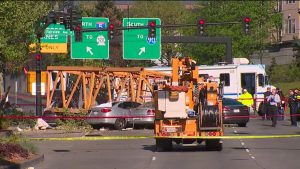 A construction crane collapsed from the roof of a building on Saturday afternoon tragically killing four people and injuring four others. Two of the people killed were ironworkers and two others were bystanders. The crane was positioned on the new Google Seattle campus and was in the process of being dismantled when it fell.
A construction crane collapsed from the roof of a building on Saturday afternoon tragically killing four people and injuring four others. Two of the people killed were ironworkers and two others were bystanders. The crane was positioned on the new Google Seattle campus and was in the process of being dismantled when it fell.
The Washington State Department of Labor and Industries is investigating five companies involved in the accident: Seaburg Construction Corp., GLY Construction, Northwest Tower Crane Service Inc., Omega Rigging and Machinery Moving Inc., and Morrow Equipment Co. LLC. The Department of Labor and Industries spokesman said that it is too early to speculate on the cause of the accident and the investigation could take up to six months and would including interviewing workers and accessing company records among other investigation.
According to an article by CNN, after a construction company is finished using a crane, disassembly can take between two and three days. The disassembly process requires taking the crane apart piece by piece. The article suggested that construction workers could have prematurely removed or loosened the pins connecting the crane all at once instead of in sections. Workers sometimes do this in order to save time during dismantling. But if pins are removed prematurely, portions of the crane become unsecure and unstable. At the time of the accident, relatively minor wind gusts between 18 and 23 mph were reported in the area and could have contributed to the collapse.
Under OSHA, certification is only required for crane operators. No formal certification is needed for construction workers responsible for the assembly and disassembly of the crane. Although there is no requisite certification, OSHA does have regulations relating to the assembly/disassembly of cranes and requires that employers must comply with the crane manufacturer’s procedures or their own developed procedures during disassembly. OSHA requires that an Assembly/Disassembly (A/D) Director be assigned, and among other responsibilities, the A/D Director must address hazards such as stability upon pin removal, loss of backward stability, and wind speed and weather. The OSHA regulations also state that pins may not be removed during disassembly when the pendants are in tension.
Under Washington law, a general contractor has an obligation to enforce safety rules on the job site. See, e.g., Stute v. PBMC, Inc., 114 Wn.2d 454, 788 P.2d 545 (1990). In Stute, the Washington State Supreme Court stated:
“Inasmuch as both the general contractor and subcontractor come within the statutory definition of employer, the primary employer, the general contractor, has, as a matter of policy, the duty to comply with or ensure compliance with WISHA and its regulations. A general contractor’s supervisory authority places the general in the best position to ensure compliance with safety regulations. For this reason, the prime responsibility for safety of all workers should rest on the general contractor.” Id. at 463.
Accordingly, attorneys looking into potential claims for the victims of the incident will look carefully at the regulations that governed the construction underway to determine if the general contractor failed to ensure compliance with applicable regulations and that the crew taking down the crane was provided with the necessary training, resources, and oversight to do the work in a safe manner.
The last crane to collapse in the area happened in Bellevue, WA in 2006 when a crane fell and killed a Microsoft attorney in his home. From 2011 to 2015, an average of 44 people were killed each year according to the Bureau of Labor Statistics in crane-related accidents. It was reported that over 3/5th of the crane-related accidents involved a falling object or equipment and in 22% of the cases the workers were engaged in construction, assembling, and dismantling activities when the accident occurred.
If you were injured in a crane-related accident, you should contact the experienced injury attorneys at Kraft Davies Olsson PLLC. The lawyers at Kraft Davies Olsson have decades of experience protecting the rights of injured construction workers and their families against large construction companies and contractors. Call Kraft Davies Olsson at 206-624-8844 or contact us through our website for your free consultation.
 Seattle Injury Lawyer Blog
Seattle Injury Lawyer Blog

